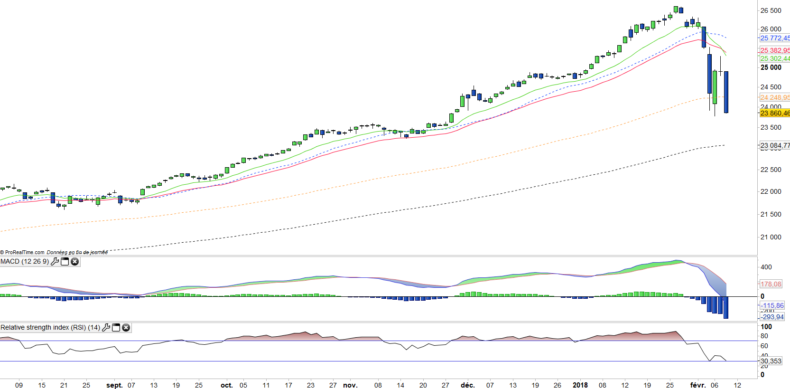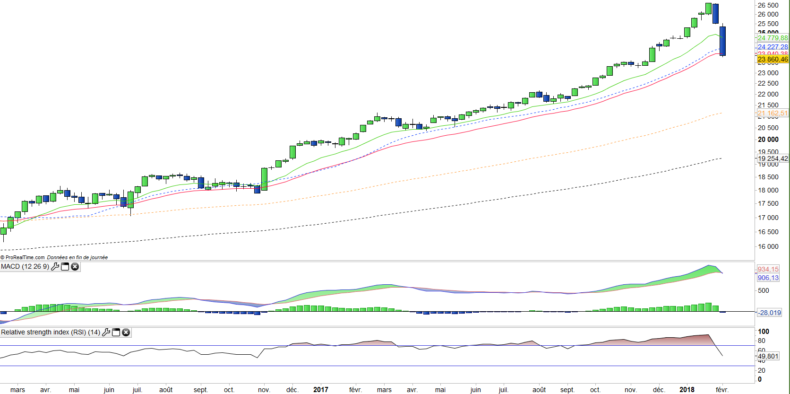SPDR ETF Dow Jones - DIA - 09/02/2018
Short Term strategy : Negative (20%) / Trend -
Long Term strategy : Positive (90%) / Trend -
Characteristics of the ETF
The DIA ETF (SPDR) replicates the Dow Jones Industrial Average index, which is composed of the 30 main US stocks, the "blue chips", selected according to the size of their market capitalization. The DIA ETF is currently the benchmark tracker to replicate the most prestigious and old US index with fees limited to 0.17% and AUM of $ 23871M. Replication is direct (physical) and there is a policy of distributing dividends on a monthly basis.
Alternative ETFs: INCD (ishares in USD)
Index & components
For a US company, integrating the Dow Jones is considered a consecration, so much must be established to achieve it, so sit there as America's iconic companies like IBM, Coca Colas, Boeing or Goldman Sachs. The value of this index is primarily the quality and robustness of its components, while the average market capitalization is $ 236 bn, with a balanced sector weighting of which the 3 main sectors are industrial stocks (24.2%) includingbig names such as 3M, Dupont de Nemours or Boeing, financial stocks (16.8%) with the big American banks, the technological sector (17%) including the most established names like IBM, Apple and Microsoft. The DJIA is a much narrower index than the S & P500 and may be more volatile, for example when financial stocks are under pressure.
The Dow Jones multiples are currently around 20x 2018 results, which is clearly in the high average (historically between 15 and 20x) but must be compared to a growth of the economy of over 2% in a context of still low interest rates and an industry sensitive to oil prices that has begun to rise. The index has been posting record highs for the last few months, and has recently climbed the 25,000 pts threshold. The index benefited from the election of D.Trump and his promises of a massive infrastructure program (pending), tax cuts (done) and the announced deregulation of banks that also benefits these sectors.
The new round of rate hikes should remain gradual unless the signs of inflation intensify, while the US dollar is falling against the Euro and other currencies which should benefit US companies, especially since the profit margins of companies are at the top of the cycle. The upward trend of the index, which has lasted for 8 years, seems to suggest that the longevity of the cycle is linked to the low rate / moderate growth pair that may still last for some time.
Latest developments
The DJIA rose by 25.1% in 2017, and has declined by -3.5% since the beginning of 2018. The sharp rise in US 10-year rates, which was accentuated in February (+40 bp to 2.85%) that threatens the bond markets and the appearance of early signs of inflation on wages in the monthly statistics for the month of January (which will have to be confirmed next month), has just provided the market a reason to correct the excesses of the last two months. The psychological threshold of 3% on US 10-year rates is not far off, and the FED could change its accommodative policy in the event of tangible signs of inflation and accelerate the pace of rate hikes which could end the US growth cycle that seems already quite mature.
The big news is also the return of volatility on the index. However this one which hit a low at 9 at the beginning of January has risen to 50 in intraday at the beginning of the week, the prices are almost down to the recent bottom of 23900 but the volatility remains for the moment on the levels of 32 which represents a significant divergence that can potentially herald a near end of the decline.
Daily Data
The daily chart shows that after the attack of the beginning of the week which stopped on the support of the 24000 pts, a strong reaction took place, materialized by a big white candlestick which was not followed up . The rebound is over and the bearish stimulus is in place with a new big black candlestick piercing the support and indicates the next step of the 23000 pts which corresponds to the EMA200 which seems an ideal place to stop the decline.
Weekly data
On the weekly chart, we can see the formation of a core of decline this week, after the bearish start at the end of last week. Moving averages are broken, which remains to be confirmed at the end of the week. This situation should lead to the bearish reversal of the technical oscillators, which will have negative consequences in the medium term. New targets are opening, the first being in the zone of 23000 pts, a level or should organize a rebound.
ETF Objective
DIA is an ETF which seeks to replicate the DJIA benchmark (30 US companies)
Characteristics
| Inception date | 14/01/1998 |
| Expense ratio | 0,17% |
| Issuer | SPDR |
| Benchmark | Dow Jones Industrial Average |
| Code/Ticker | DIA |
| ISIN | US78467X1090 |
| UCITS | No |
| Currency | $ |
| Exchange | NYSE Arca |
| Assets Under Management | 23 871 M$ |
| Dividend | distribution |
| Currency Risk | No |
| Number of Holdings | 30 |
| Risk | 3/5 |
Country Breakdown
| USA | 100% |
Sector Breakdown
| Industrials | 24% |
| Information Technology | 17% |
| Financials | 17% |
| Consumer Discretionary | 15% |
| Health Care | 13% |
| Consumer Staples | 6% |
| Energy | 5% |
| Materials | 2% |
| Telecommunication Services | 2% |
Top Ten Holdings
| Boeing | 10% |
| Goldman Sachs | 7% |
| 3M Company | 6% |
| UnitedHealth Group | 6% |
| Mac Donald | 5% |
| Home Depot | 5% |
| Apple | 4% |
| Caterpillar | 4% |
| IBM | 4% |
| Johnson & Johnson | 4% |


